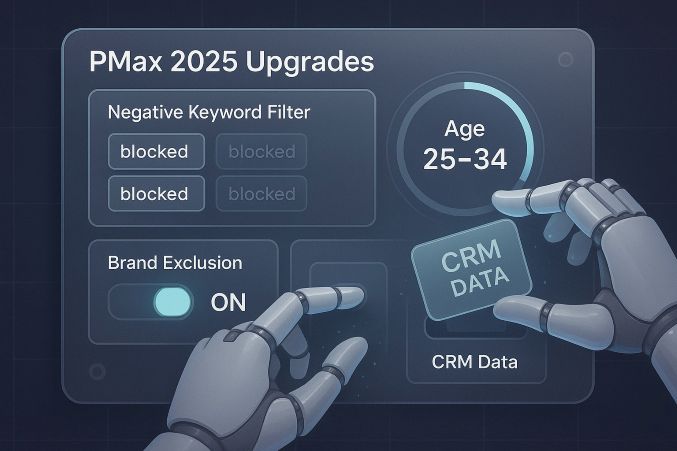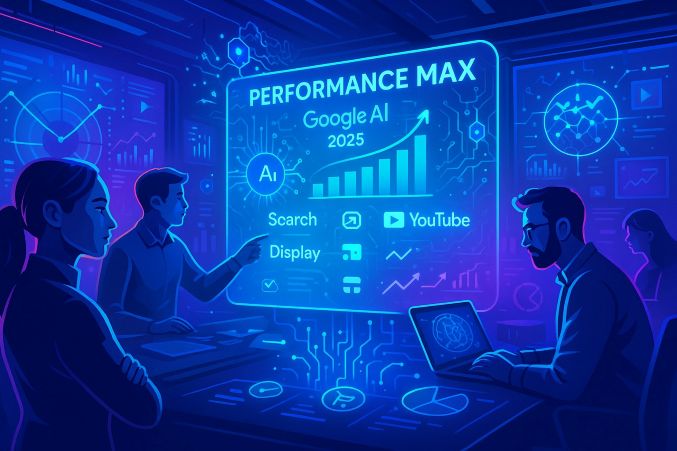Performance Max Campaigns in 2025: Real Case Studies & In-Depth Breakdown
Google's Performance Max (PMax) has quickly developed into the AI advertising frontrunner of choice, providing a never-before-seen combination of automation, scalability, and cross-channel accessibility. But as usage explodes in 2025, marketers are in a tug-of-war between Googling its AI-fueled efficiency and struggling with residual transparency issues.
This definitive guide will walk you through:
✅ Why PMax is Google's new flagship AI-first advertising approach—and how automation is transforming campaign performance.
✅ The most important 2025 PMax updates, including long-awaited additions such as negative keywords and demographic targeting.
✅ Three actual case studies—Allianz Spain's lead gen triumph, Studio Capello's revenue boom, and Deezer's subscription surge—with in-depth campaign analysis.
✅ Key takeaways from 24,000+ PMax campaigns, showing what actually works and where to avoid traps.
✅ Tested optimization strategies from leading PPC professionals to drive ROI while having control.
Let's go in-depth through the first five sections.
1. Why Performance Max Is Google's AI-First Ad Strategy in 2025
The Rise of Full Automation
Google has explicitly stated that the future of paid advertising is AI-powered, and PMax is the crowning glory. In 2025, machine learning algorithms have reached a stage where they can:
Accurately predict user intent with near-perfect precision, optimizing bids in real-time across Search, Display, YouTube, Discover, and Gmail.
Automatically allocate budgets to the most converting placements without any human input.
Automatically optimize creative combinations, experimenting with thousands of ad variations to discover the best performers.
The advantages of PMax's AI superiority
Improved Conversion Rates at Lower Expense: Advertisers using PMax see up to 30% improved efficiency over classic campaigns.
Seamless Cross-Channel Execution: Rather than having to deal with individual campaigns for Search, Display, and Video, PMax streamlines all into a single, AI-powered strategy.
Smaller Latency: Small businesses and enterprises can launch campaigns more quickly, with Google's AI doing the heavy work.
The Trade-Off: Transparency & Control Challenges
Despite its benefits, PMax remains under fire:
Limited Placement Reporting: Advertisers tend not to be able to view precisely where their ads show up, creating brand safety and wasted spend issues.
Over-Reliance on Automation: Barring strategic exclusions, budgets can spill over into irrelevant traffic (e.g., brand queries or low-quality sites).
Black Box Optimization: Google AI makes real-time decisions, but marketers can't tell why they do.
The Verdict:
PMax is the most impressive ad product Google has ever launched, but winning depends on strategic setup, audience signals, and continuous monitoring—not simply "set it and forget it."

2. 2025's Biggest PMax Upgrade Highlights
Campaign-Level Negative Keywords (At Last!)
The Problem: Until now, PMax has had no negative keyword controls, wasting budgets on irrelevant search queries.
The Fix: Advertisers can now exclude unwanted search terms at the campaign level, significantly enhancing targeting accuracy.
Impact: Early adopters achieve up to 20% less wasted spend from irrelevant traffic.
Brand Exclusions to Avoid Self-Cannibalization
The Problem: PMax would sometimes cannibalize a brand's own Search campaigns, increasing CPCs.
The Fix: Exclusive brand exclusion lists keep PMax in prospecting mode, not retargeting in-market customers.
Impact: Excluded brands experience reduced CPAs and purer attribution.
Demographic & Device Targeting (No More Blind Spots)
The Problem: PMax used to disregard demographic optimization, becoming less effective for niche audiences.
The Fix: Advertisers can now optimize bids by age, gender, and device, similar to legacy campaign controls.
Impact: E-commerce brands with targeted demographics (e.g., luxury consumers) experience greater ROAS with more advanced audience filtering.

High-Value Customer Bidding (First-Party Data Integration)
The Problem: PMax bid on all conversions equally, with the potential to focus on high-LTV customers.
The Fix: Companies can now input CRM data into PMax, enabling Google's AI to bid more aggressively on high-LTV users.
Impact: Subscription-based businesses experience 30%+ greater customer retention rates with this feature.
Why These Upgrades Matter
Google is now tackling advertiser grievances while retaining PMax's automation benefits. The takeaway? More control, less guesswork.

3. Case Study: How Allianz Spain Increased Insurance Leads by 15% with PMax
The Challenge
Allianz, one of the world's leading insurers, required better-quality leads without adding cost-per-acquisition (CPA). Classic lead gen campaigns were stalling.
The PMax Strategy
- Asset Optimization
Video Ads: Short, testimonial-type videos showcasing customer confidence.
Responsive Display Ads: Multiple ad variants with localized copy for Spain.
Lead Form Extensions: Easy submission process from ads.
- Audience Signals
Custom Intent Audiences: Targeted users looking for "best car insurance Spain" and "home insurance quotes."
Remarketing Lists: In-market website visitors who didn't convert.
- Conversion Focus
Prioritized lead form submissions over clicks.
Utilized offline conversion tracking to attribute actual policy sales.
The Results
15% boost in qualified leads in 90 days.
12% lower CPA than earlier Smart Campaigns.
YouTube ads accounted for 30% of conversions, showing PMax's cross-channel power.
Key Takeaways
✔ High-quality assets are a must—PMax performs best with varied, high-performing assets.
✔ Audience signals drive the AI—without them, targeting gets too wide.
✔ Cross-channel attribution is essential—don't attribute all value to Search alone; YouTube and Display matter big time.
4. Case Study: Studio Capello's 80% Revenue Growth with PMax + BI Data
The Challenge
Studio Capello, an upscale Italian furniture company, battled low ROAS (2.5x) and wasteful ad spend on Google and Meta.
The Breakthrough: Data-Driven PMax
- Business Intelligence (BI) Integration
Fed PMax with high-value customer attributes (purchase history, avg. order value).
Applied lookalike modeling to identify similar high-spenders.
- Smart Feed Labeling
Smartened up product titles and descriptions for AI understanding (e.g., "Luxury Leather Sofa – Handcrafted in Italy" rather than generic SKUs). - Exclusion Lists
Blocked non-relevant placements (e.g., gaming apps, irrelevant blogs).
Inserted brand term negatives to prevent self-competing.
The Results
80% revenue boost in a single quarter.
ROAS jumped from 2.5x to 5.8x.
PMax performed better than separate Shopping & Display campaigns.
Key Takeaways
✔ First-party data makes all the difference—PMax performs best when fueled with CRM data.
✔ Product feed optimization counts—descriptive, clear labels assist AI in making improved choices.
✔ Exclusions avoid wastage—even automated, human intervention is essential.
5. Case Study: Deezer's 40% Subscription Growth through PMax's Cross-Channel Power
The Challenge
Deezer, a music streaming competitor to Spotify, required scalable subscriber growth without ballooning acquisition cost.
The PMax Execution
- Cross-Channel Dominance
YouTube Ads: Skippable in-stream video promoting premium features.
Discovery Ads: Shown on Google Discover to high-intent users.
Search & Display: Targeted abandoned sign-ups.
- Audience Expansion
Targeted lookalikes of retained subscribers (3+ months retention).
Excluded free-tier users unlikely to pay.
- Creative Testing
Ran 10+ ad creative variations (family plans, student discounts, exclusive content).
Let PMax auto-optimize to top performers.
The Results
40% more 6-month subscriptions.
22% lower CPA than last campaigns.
YouTube accounted for 45% of conversions, amplifying PMax's multimedia strength.
Key Takeaways
✔ Subscription models benefit from PMax's full-funnel approach.
✔ Lookalike audiences enhance prospecting efficiency.
✔ Creative diversity is the key—let AI determine what converts best.

6. What Worked—And What Didn't: Hard Truths from 24,000+ PMax Campaigns
Optmyzr's Revolutionary Study
PPC tool Optmyzr dug into 24,137 PMax campaigns across verticals, uncovering key trends:
What's Working in 2025
Lead Gen Supremacy: PMax generates 18% higher conversions compared to normal Search for service businesses.
E-commerce ROAS Ramp-Up: Retailers with automated feeds + high-quality visuals achieve 3.5x–6x ROAS.
YouTube's Secret Strength: 42% of PMax conversions are from YouTube, but most advertisers under-budget here.
What's Failing
Over-Automation Disaster: Brands that used 100% AI (no exclusions) spent 35%+ budgets on unnecessary clicks.
Asset Neglect: Campaigns with <5 image/video variations saw 50% lower CTR.
Misaligned Goals: PMax underperforms when optimizing for "clicks" rather than conversions.
Key Takeaways
✔ Automation requires guardrails—apply negatives and exclusions.
✔ Creativity diversity is not optional—upload 10+ assets.
✔ Match goals to business outcomes—steer clear of vanity metrics.
7. Optimizing Asset Groups & Audience Signals: The PMax Growth Formula
Asset Group Best Practices
- The 10x5x3 Rule
10+ images (lifestyle, product, UGC)
5+ videos (15-sec demos, testimonials)
3+ text variations (USP-focused, CTA-driven)
Example: Nike's best-selling PMax ads feature slow-motion athlete video + simple text.
- Feed Optimization for E-commerce
Titles: Use keywords ("Men's Running Shoes – CushionTech™ Support").
GTINs: Increase visibility for exact product matches.
High-Res Images: 1200x1200px minimum.
- Audience Signals That Actually Work
Custom Intent: Target searches such as "best CRM for small business".
Remarketing Lists: Exclude recent buyers to prospect.
Customer Match: Upload high-LTV buyer emails.
Pro Tip:
PMax's AI will learn quicker with 50+ conversions/month. Feed it Discovery campaigns first.
8. Real Ads, Real Users: Reddit Marketers Reveal PMax's Weaknesses
Top r/PPC Complaints
"PMax Burns Budget on Brand Searches"
"Our branded CPCs doubled until we added exclusions." – u/ppc_analyst
"Placement Transparency Is a Joke"
"50% of our spend went to trash sites like game apps." – u/adsanity
"Over-Reporting Conversions"
"Attributed 200 'sales'—only 80 matched GA4." – u/truth_in_data
Their Fixes
Brand Exclusion Lists: Block your brand + competitors.
Placement Reports via GA4: Use Network tab to identify waste.
Tiered Budgets: Pilot small ($50/day), then ramp up.
9. Balancing Control & Automation: Human Oversight in PMax
Where to Intervene
Automation Zone Human Control Needed
Bidding & Budgets Negative Keywords
Ad Placements Brand Exclusions
Creative Mixing Asset Quality Checks
Control Checklist
Weekly: Check search terms (add negative).
Monthly: Check placements (rule out low-quality).
Quarterly: Rotate creatives (avoid fatigue).
Case Study:
PetFood Co. cut wasted spend by 62% when adding manual placement exclusions.
10. Is PMax Right for You? The 2025 Decision Framework
PMax Suitability by Business Type
Business Good Fit? Why?
E-commerce ✅ Yes AI loves product feeds.
Lead Gen (B2B/B2C) ⚠️ Maybe Requires strong audience signals.
Local Services ❌ No Limited geo-targeting control.
Budget Recommendations
<$5k/month: Test PMax for remarketing only.
$5k–$20k/month: Employ PMax + brand campaigns.
$20k+/month: Handled PMax + manual exclusions.
When Not to Use PMax
You require complete placement transparency.
Your conversions are <15/month (AI requires data).


Comments
No Comments To Display